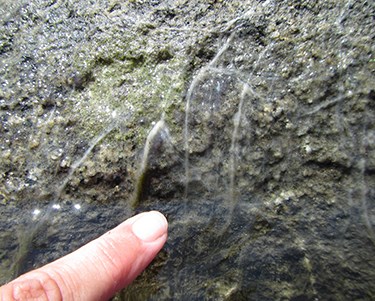
Didymo (Didymosphenia geminata) is a type of invasive algae that attaches to plants, rocks, and other hard substrates in rivers and streams. Also called “rock snot” due to its slimy appearance, Didymo can produce thick mats that cover stream beds—making swimming, fishing, and other water activities undesirable. People, including fishermen, are thought to be the main way that Didymo is being spread from one place to another. Recreational equipment, including clothing, can become contaminated and encourage the spread of Didymo if not cleaned properly before being used in another body of water. Didymo is a native to North America that historically occurred in cool, low-nutrient waters. Since the mid-1980s, it has expanded its ecological niche to include a wide range of water temperatures and nutrient levels. In early stages, Didymo forms small bubbly colonies and a thick brown layer on rocks. As it grows, it can form thick dense finger-like clumps. In advanced stages, it forms long streaming filamentous carpets, several centimeters long. Streamers turn white at their ends, and fragments float downstream, appearing similar to clumps of tissue paper. Blooms can look similar to a sewage spill with wet toilet paper streaming down the river. Although it looks slimy, it feels like wet wool or cotton. Didymo has been documented in several locations along the Tuolumne River, including locations in Yosemite National Park below the O’Shaughnessy Dam. Park managers are concerned that Didymo could become established in other park waters, potentially altering the natural ecosystem. No blooms have been documented in the park, but blooms have been documented in several streams located on the eastern boundary of the park. Didymo has extraordinary capacity to impact river and stream ecosystems. It attaches to submerged substrate on streambeds by excreting a stalk that is resistant to degradation by bacteria and fungi. Under nuisance bloom conditions, it produces numerous extracellular stalks that attach to rocks and plants. Stalks form dense mats that trail downstream. As the stalks lengthen, the brown mats shred into the stream and can be washed white at the ends. Extensive blooms have been known to cover several miles of waterways, making it nearly impossible to eradicate once it’s established. The mats, which can be over 8 inches thick, are capable of completely covering the substrate, engulfing the stream bottom, smothering native plants, insects, and mollusks causing extensive damage to the ecosystem. Didymo can also grow on grates and other components of water systems, blocking water flow. 
How You Can HelpFollow these guidelines to help prevent the spread. These activities are especially important if you have been in waters where Didymo or other invasive species are known to exist. Before moving to a new location in a different body of water:
Report ItFollow these guidelines to help prevent the spread. These activities are especially important if you have been in waters where Didymo or other invasive species are known to exist. If you think you have seen a Didymo bloom, please report it. Write a brief description of what you saw and where. If possible, take photos of the suspect bloom and the GPS coordinates. Drop off your report at a visitor center, or email the report to our park aquatic ecologist. |
Last updated: August 21, 2019
